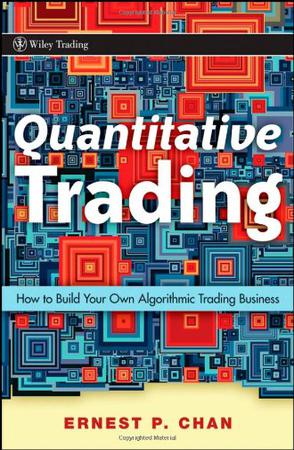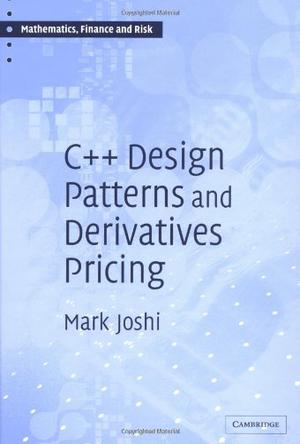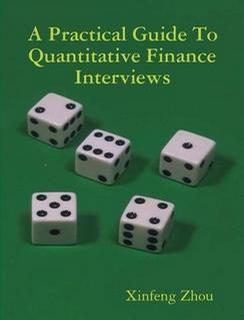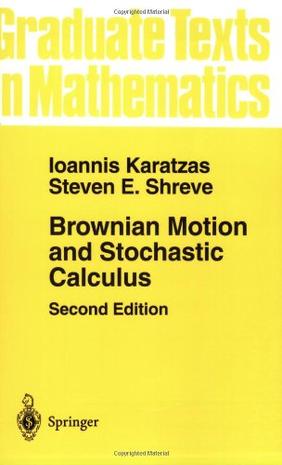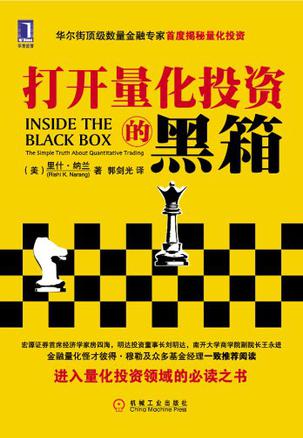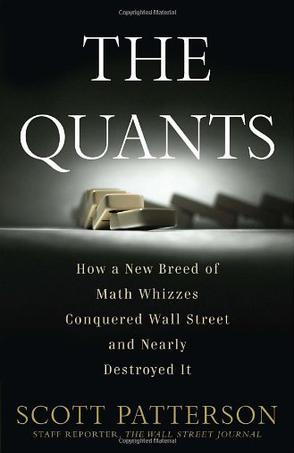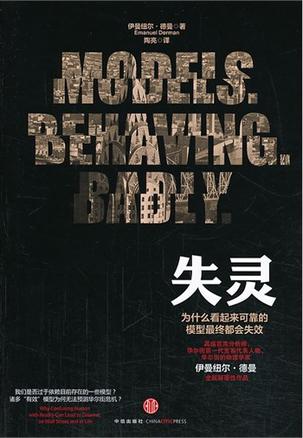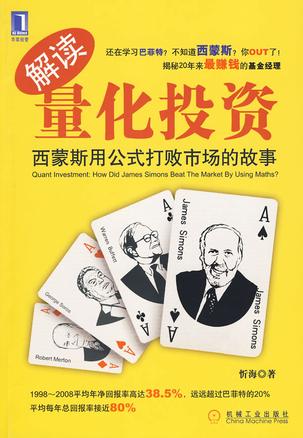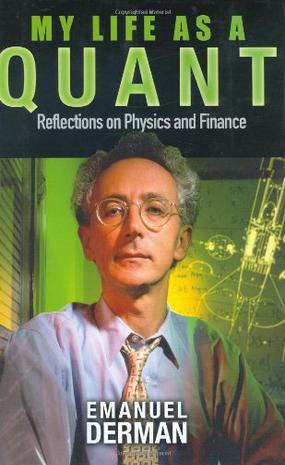欢迎来到相识电子书!
标签:quant
-
Quantitative Trading
By some estimates, quantitative (or algorithmic) trading now accounts for over one-third of trading volume in the United States. While institutional traders continue to implement this highly effective approach, many independent traders—with limited resources and less computing power—have wondered if they can still challenge powerful industry professionals at their own game? The answer is "yes," and in Quantitative Trading, author Dr. Ernest Chan, a respected independent trader and consultant, will show you how. Whether you're an independent "retail" trader looking to start your own quantitative trading business or an individual who aspires to work as a quantitative trader at a major financial institution, this practical guide contains the information you need to succeed. Organized around the steps you should take to start trading quantitatively, this book skillfully addresses how to: * Find a viable trading strategy that you're both comfortable with and confident in * Backtest your strategy—with MATLAB®, Excel, and other platforms—to ensure good historical performance * Build and implement an automated trading system to execute your strategy * Scale up or wind down your strategies depending on their real-world profitability * Manage the money and risks involved in holding positions generated by your strategy * Incorporate advanced concepts that most professionals use into your everyday trading activities * And much more While Dr. Chan takes the time to outline the essential aspects of turning quantitative trading strategies into profits, he doesn't get into overly theoretical or sophisticated theories. Instead, he highlights the simple tools and techniques you can use to gain a much-needed edge over today's institutional traders. And for those who want to keep up with the latest news, ideas, and trends in quantitative trading, you're welcome to visit Dr. Chan's blog, epchan.blogspot.com, as well as his premium content Web site, epchan.com/subscriptions, which you'll have free access to with purchase of this book. As an independent trader, you're free from the con-straints found in today's institutional environment—and as long as you adhere to the discipline of quantitative trading, you can achieve significant returns. With this reliable resource as your guide, you'll quickly discover what it takes to make it in such a dynamic and demanding field. -
Financial Calculus
The rewards and dangers of speculating in the modern financial markets have come to the fore in recent times with the collapse of banks and bankruptcies of public corporations as a direct result of ill-judged investment. At the same time, individuals are paid huge sums to use their mathematical skills to make well-judged investment decisions. Here now is the first rigorous and accessible account of the mathematics behind the pricing, construction and hedging of derivative securities. Key concepts such as martingales, change of measure, and the Heath-Jarrow-Morton model are described with mathematical precision in a style tailored for market practitioners. Starting from discrete-time hedging on binary trees, continuous-time stock models (including Black-Scholes) are developed. Practicalities are stressed, including examples from stock, currency and interest rate markets, all accompanied by graphical illustrations with realistic data. A full glossary of probabilistic and financial terms is provided. This unique, modern and up-to-date book will be an essential purchase for market practitioners, quantitative analysts, and derivatives traders, whether existing or trainees, in investment banks in the major financial centres throughout the world. -
Arbitrage Theory in Continuous Time
The third edition of this popular introduction to the classical underpinnings of the mathematics behind finance continues to combine sound mathematical principles with economic applications. Concentrating on the probabilistic theory of continuous arbitrage pricing of financial derivatives, including stochastic optimal control theory and Merton's fund separation theory, the book is designed for graduate students and combines necessary mathematical background with a solid economic focus. It includes a solved example for every new technique presented, contains numerous exercises, and suggests further reading in each chapter. In this substantially extended new edition Bjork has added separate and complete chapters on the martingale approach to optimal investment problems, optimal stopping theory with applications to American options, and positive interest models and their connection to potential theory and stochastic discount factors. More advanced areas of study are clearly marked to help students and teachers use the book as it suits their needs. -
A Practical Guide To Quantitative Finance Interviews
This book will prepare you for quantitative finance interviews by helping you zero in on the key concepts that are frequently tested in such interviews. In this book we analyze solutions to more than 200 real interview problems and provide valuable insights into how to ace quantitative interviews. The book covers a variety of topics that you are likely to encounter in quantitative interviews: brain teasers, calculus, linear algebra, probability, stochastic processes and stochastic calculus, finance and programming. -
Brownian Motion and Stochastic Calculus
A graduate-course text, written for readers familiar with measure-theoretic probability and discrete-time processes, wishing to explore stochastic processes in continuous time. The vehicle chosen for this exposition is Brownian motion, which is presented as the canonical example of both a martingale and a Markov process with continuous paths. In this context, the theory of stochastic integration and stochastic calculus is developed, illustrated by results concerning representations of martingales and change of measure on Wiener space, which in turn permit a presentation of recent advances in financial economics. The book contains a detailed discussion of weak and strong solutions of stochastic differential equations and a study of local time for semimartingales, with special emphasis on the theory of Brownian local time. The whole is backed by a large number of problems and exercises. -
Stochastic Calculus for Finance I
Developed for the professional Master's program in Computational Finance at Carnegie Mellon, the leading financial engineering program in the U.S. Has been tested in the classroom and revised over a period of several years Exercises conclude every chapter; some of these extend the theory while others are drawn from practical problems in quantitative finance -
Stochastic Calculus for Finance II
在线阅读本书 Stochastic Calculus for Finance evolved from the first ten years of the Carnegie Mellon Professional Master's program in Computational Finance. The content of this book has been used successfully with students whose mathematics background consists of calculus and calculus-based probability. The text gives both precise statements of results, plausibility arguments, and even some proofs, but more importantly intuitive explanations developed and refine through classroom experience with this material are provided. The book includes a self-contained treatment of the probability theory needed for stochastic calculus, including Brownian motion and its properties. Advanced topics include foreign exchange models, forward measures, and jump-diffusion processes. This book is being published in two volumes. This second volume develops stochastic calculus, martingales, risk-neutral pricing, exotic options and term structure models, all in continuous time. Master's level students and researchers in mathematical finance and financial engineering will find this book useful. -
How I Became a Quant
Praise for How I Became a Quant "Led by two top-notch quants, Richard R. Lindsey and Barry Schachter, How I Became a Quant details the quirky world of quantitative analysis through stories told by some of today's most successful quants. For anyone who might have thought otherwise, there are engaging personalities behind all that number crunching!" --Ira Kawaller, Kawaller & Co. and the Kawaller Fund "A fun and fascinating read. This book tells the story of how academics, physicists, mathematicians, and other scientists became professional investors managing billions." --David A. Krell, President and CEO, International Securities Exchange "How I Became a Quant should be must reading for all students with a quantitative aptitude. It provides fascinating examples of the dynamic career opportunities potentially open to anyone with the skills and passion for quantitative analysis." --Roy D. Henriksson, Chief Investment Officer, Advanced Portfolio Management "Quants"--those who design and implement mathematical models for the pricing of derivatives, assessment of risk, or prediction of market movements--are the backbone of today's investment industry. As the greater volatility of current financial markets has driven investors to seek shelter from increasing uncertainty, the quant revolution has given people the opportunity to avoid unwanted financial risk by literally trading it away, or more specifically, paying someone else to take on the unwanted risk. How I Became a Quant reveals the faces behind the quant revolution, offering you?the?chance to learn firsthand what it's like to be a?quant today. In this fascinating collection of Wall Street war stories, more than two dozen quants detail their roots, roles, and contributions, explaining what they do and how they do it, as well as outlining the sometimes unexpected paths they have followed from the halls of academia to the front lines of an investment revolution. -
打开量化投资的黑箱
《打开量化投资的黑箱》内容简介:量化交易策略被投资大众称为“黑箱”,以难以理解并且难以描述而得名。尽管这种投资方法具有一定的复杂度,但如果得到很好的指导,您同样可以顺利进入这个领域,领略到其中的奥妙。 《打开量化投资的黑箱》作者里什•纳兰是一位专业基金经理,在书中他站在一个非纯粹技术性的视角介绍了量化交易策略,用生动的文笔带领读者游历整个“黑箱”。 《打开量化投资的黑箱》的写作翔实生动,涉猎了金融界丰富的真实案例和市场趣闻,富于智慧地描绘了华尔街的数量金融奇才们是如何工作的。 阅读《打开量化投资的黑箱》的过程,是您掀开量化交易神秘面纱的过程,是您慢慢理解数量金融大师及其投资策略的过程,也可能是您对量化交易越来越感兴趣的过程。 -
The Quants
“Beware of geeks bearing formulas.” --Warren Buffett In March of 2006, the world’s richest men sipped champagne in an opulent New York hotel. They were preparing to compete in a poker tournament with million-dollar stakes, but those numbers meant nothing to them. They were accustomed to risking billions. At the card table that night was Peter Muller, an eccentric, whip-smart whiz kid who’d studied theoretical mathematics at Princeton and now managed a fabulously successful hedge fund called PDT…when he wasn’t playing his keyboard for morning commuters on the New York subway. With him was Ken Griffin, who as an undergraduate trading convertible bonds out of his Harvard dorm room had outsmarted the Wall Street pros and made money in one of the worst bear markets of all time. Now he was the tough-as-nails head of Citadel Investment Group, one of the most powerful money machines on earth. There too were Cliff Asness, the sharp-tongued, mercurial founder of the hedge fund AQR, a man as famous for his computer-smashing rages as for his brilliance, and Boaz Weinstein, chess life-master and king of the credit default swap, who while juggling $30 billion worth of positions for Deutsche Bank found time for frequent visits to Las Vegas with the famed MIT card-counting team. On that night in 2006, these four men and their cohorts were the new kings of Wall Street. Muller, Griffin, Asness, and Weinstein were among the best and brightest of a new breed, the quants . Over the prior twenty years, this species of math whiz --technocrats who make billions not with gut calls or fundamental analysis but with formulas and high-speed computers-- had usurped the testosterone-fueled, kill-or-be-killed risk-takers who’d long been the alpha males the world’s largest casino. The quants believed that a dizzying, indecipherable-to-mere-mortals cocktail of differential calculus, quantum physics, and advanced geometry held the key to reaping riches from the financial markets. And they helped create a digitized money-trading machine that could shift billions around the globe with the click of a mouse. Few realized that night, though, that in creating this unprecedented machine, men like Muller, Griffin, Asness and Weinstein had sowed the seeds for history’s greatest financial disaster. Drawing on unprecedented access to these four number-crunching titans, The Quants tells the inside story of what they thought and felt in the days and weeks when they helplessly watched much of their net worth vaporize – and wondered just how their mind-bending formulas and genius-level IQ’s had led them so wrong, so fast. Had their years of success been dumb luck, fool’s gold, a good run that could come to an end on any given day? What if The Truth they sought -- the secret of the markets -- wasn’t knowable? Worse, what if there wasn’t any Truth? In The Quants , Scott Patterson tells the story not just of these men, but of Jim Simons, the reclusive founder of the most successful hedge fund in history; Aaron Brown, the quant who used his math skills to humiliate Wall Street’s old guard at their trademark game of Liar’s Poker, and years later found himself with a front-row seat to the rapid emergence of mortgage-backed securities; and gadflies and dissenters such as Paul Wilmott, Nassim Taleb, and Benoit Mandelbrot. With the immediacy of today’s NASDAQ close and the timeless power of a Greek tragedy, The Quants is at once a masterpiece of explanatory journalism, a gripping tale of ambition and hubris…and an ominous warning about Wall Street’s future. -
Frequently Asked Questions in Quantitative Finance
"Getting agreement between finance theory and finance practice is important like never before. In the last decade the derivatives business has grown to a staggering size, such that the outstanding notional of all contracts is now many multiples of the underlying world economy. No longer are derivatives for helping people control and manage their financial risks from other business and industries, no, it seems that the people are toiling away in the fields to keep the derivatives market afloat (Apologies for the mixed metaphor ) If you work in derivatives, risk, development, trading, etc. you'd better know what you are doing, there's now a big responsibility on your shoulders. In this second edition of "Frequently Asked Questions in Quantitative Finance" I continue in my mission to pull quant finance up from the dumbed-down depths, and to drag it back down to earth from the super-sophisticated stratosphere. Readers of my work and blogs will know that I think both extremes are dangerous. Quant finance should inhabit the middle ground, the mathematics sweet spot, where the models are robust and understandable, and easy to mend. ...And that's what this book is about. This book contains important FAQs and answers that cover both theory and practice. There are sections on how to derive Black-Scholes (a dozen different ways ), the popular models, equations, formulas and probability distributions, critical essays, brainteasers, and the commonest quant mistakes. The quant mistakes section alone is worth trillions of dollars I hope you enjoy this book, and that it shows you how interesting this important subject can be. And I hope you'll join me and others in this industry on the discussion forum on wilmott.com. See you there " "FAQQF2."..including key models, important formulae, popular contracts, essays and opinions, a history of quantitative finance, sundry lists, the commonest mistakes in quant finance, brainteasers, plenty of straight-talking, the Modellers' Manifesto and lots more. Paul Wilmott has been called "the smartest of the quants, he may be the only smart quant" ("Portfolio" magazine/Nassim Nicholas Taleb), "cult derivatives lecturer" ("Financial Times"), "the finance industry's Mozart" ("Sunday Business"), "financial mathematics guru" (BBC) and "a very naughty boy" (his mother). -
金融随机分析(共2册)
《金融随机分析(共2卷)》是《金融随机分析》的第2卷,《金融随机分析》全书共分两卷。第一卷主要包括随机分析的基础性知识以及离散时问模型,利用较简单的离散时间二叉树模型给出了无套利期权定价方法;虽只用到简单的数学,但其中涉及的风险中性定价的概念卜分深刻。第二卷主要介绍连续时问模型及其在金融学中的应用;其中包含了较为实际的、具有很强操作性的定量经济学内容,同时也包含了较为完整的随机分析理论。全书各章均有评注和习题。 -
Financial Modeling
Too often, finance courses stop short of making a connection between textbook finance and the problems of real-world business. Financial Modeling bridges this gap between theory and practice by providing a nuts-and-bolts guide to solving common financial models with spreadsheets. Simon Benninga takes the reader step by step through each model, showing how it can be solved using Microsoft Excel. The long-awaited third edition of this standard text maintains the "cookbook" features and Excel dependence that have made the first and second editions so popular. It also offers significant new material, with new chapters covering such topics as bank valuation, the Black-Litterman approach to portfolio optimization, Monte Carlo methods and their applications to option pricing, and using array functions and formulas. Other chapters, including those on basic financial calculations, portfolio models, calculating the variance-covariance matrix, and generating random numbers, have been revised, with many offering substantially new and improved material. Other areas covered include financial statement modeling, leasing, standard portfolio problems, value at risk (VaR), real options, duration and immunization, and term structure modeling. Technical chapters treat such topics as data tables, matrices, the Gauss-Seidel method, and tips for using Excel. The last section of the text covers the Visual Basic for Applications (VBA) techniques needed for the book. The accompanying CD contains Excel worksheets and solutions to end-of-chapter exercises. -
Options, Futures and Other Derivatives (6th Edition)
Designed to bridge the gap between theory and practice, this successful book is regarded as "the bible" in trading rooms throughout the world. The books covers both derivatives markets and risk management, including credit risk and credit derivatives; forward, futures, and swaps; insurance, weather, and energy derivatives; and more. For options traders, options analysts, risk managers, swaps traders, financial engineers, and corporate treasurers. -
失灵
在华尔街做数量分析工作的物理学家通常被称为宽客,宽客建立模型的初衷是让华尔街能够避开风险、繁荣发展。但是在金融危机中,宽客们饱受指责,大家认为是宽客建立的复杂数学模型引发了金融危机。是什么让这些模型如此危险呢? 伊曼纽尔•德曼(Emanuel Derman)之前曾作为宽客在华尔街工作,他以业内人士的视角,犀利地分析了模型与人类认知之间的冲突。在个人生活甚至政治领域中,我们总能发现所谓的科学严谨并不那么令人信服。数学模型与物理模型关系极为密切,但是在物理领域,理论旨在描述事实,而在金融领域,模型只是尽可能地逼近事实。 德曼用金融理论和实践的亲身体验解释了看来可靠的模型为何会失效,为什么金融模型会使经济崩溃,并且提出了制定模型的一些基本原则,从而帮助人们逃脱模型所带来的束缚。 -
解读量化投资
《解读量化投资:西蒙斯用公式打败市场的故事》内容简介:詹姆斯·西蒙斯,基金领域的拓扑学大腕,成功取代保尔森的对冲之王,20年内最佳赚钱基金经理,在投资界掀起了一场量化投资的狂潮。《解读量化投资:西蒙斯用公式打败市场的故事》用轻松、幽默的讲故事手法,解读了西蒙斯量化投资“黑箱”之内的秘密。通过深入浅出地回顾西蒙斯的投资布阵,比较西蒙斯与巴菲特投资模式的迥异,分析投资领域技术分析方法和宏观分析方法的优劣,《解读量化投资:西蒙斯用公式打败市场的故事》带我们走近了20年中平均每年总回报为80%的大奖章基金,看看它如何能将1万元变成1亿元。用数学公式打败市场,投资并非悬而未决的事情——这就是《解读量化投资:西蒙斯用公式打败市场的故事》揭示的投资之道。 -
How I Became a Quant
Praise for How I Became a Quant "Led by two top-notch quants, Richard R. Lindsey and Barry Schachter, How I Became a Quant details the quirky world of quantitative analysis through stories told by some of today's most successful quants. For anyone who might have thought otherwise, there are engaging personalities behind all that number crunching!" --Ira Kawaller, Kawaller & Co. and the Kawaller Fund "A fun and fascinating read. This book tells the story of how academics, physicists, mathematicians, and other scientists became professional investors managing billions." --David A. Krell, President and CEO, International Securities Exchange "How I Became a Quant should be must reading for all students with a quantitative aptitude. It provides fascinating examples of the dynamic career opportunities potentially open to anyone with the skills and passion for quantitative analysis." --Roy D. Henriksson, Chief Investment Officer, Advanced Portfolio Management "Quants"--those who design and implement mathematical models for the pricing of derivatives, assessment of risk, or prediction of market movements--are the backbone of today's investment industry. As the greater volatility of current financial markets has driven investors to seek shelter from increasing uncertainty, the quant revolution has given people the opportunity to avoid unwanted financial risk by literally trading it away, or more specifically, paying someone else to take on the unwanted risk. How I Became a Quant reveals the faces behind the quant revolution, offering you?the?chance to learn firsthand what it's like to be a?quant today. In this fascinating collection of Wall Street war stories, more than two dozen quants detail their roots, roles, and contributions, explaining what they do and how they do it, as well as outlining the sometimes unexpected paths they have followed from the halls of academia to the front lines of an investment revolution. -
My Life as a Quant
在线阅读本书 In My Life as a Quant, Emanuel Derman relives his exciting journey as one of the first high–energy particle physicists to migrate to Wall Street. Page by page, Derman details his adventures in this field—analyzing the incompatible personas of traders and quants, and discussing the dissimilar nature of knowledge in physics and finance. Throughout this tale, he also reflects on the appropriate way to apply the refined methods of physics to the hurly–burly world of markets. -
My Life as a Quant
Emanuel Derman was one of the first physicists to move to Wall Street, and his career paralleled the growth of quantitative trading over the past twenty years. In My Life as a Quant, he traces his transformation from ambitious young scientist to managing director and head of the renowned Quantitative Strategies group at Goldman, Sachs & Co. Derman’s tale recounts his adventures with quants, traders and other high fliers on Wall Street as he became the best-known quant in the business. He describes the struggles of research and his interactions with an assorted cast of famous scientists. He relates his impressions of some of the most creative minds on Wall Street, including Fischer Black, with whom he collaborated on the widely used Black-Derman-Toy model of interest rates. Throughout his story he reflects on the appropriate way to apply the refined methods of physics to the hurly-burly world of markets and the people that inhabit them.
热门标签
下载排行榜
- 1 梦的解析:最佳译本
- 2 李鸿章全传
- 3 淡定的智慧
- 4 心理操控术
- 5 哈佛口才课
- 6 俗世奇人
- 7 日瓦戈医生
- 8 笑死你的逻辑学
- 9 历史老师没教过的历史
- 10 1分钟和陌生人成为朋友

